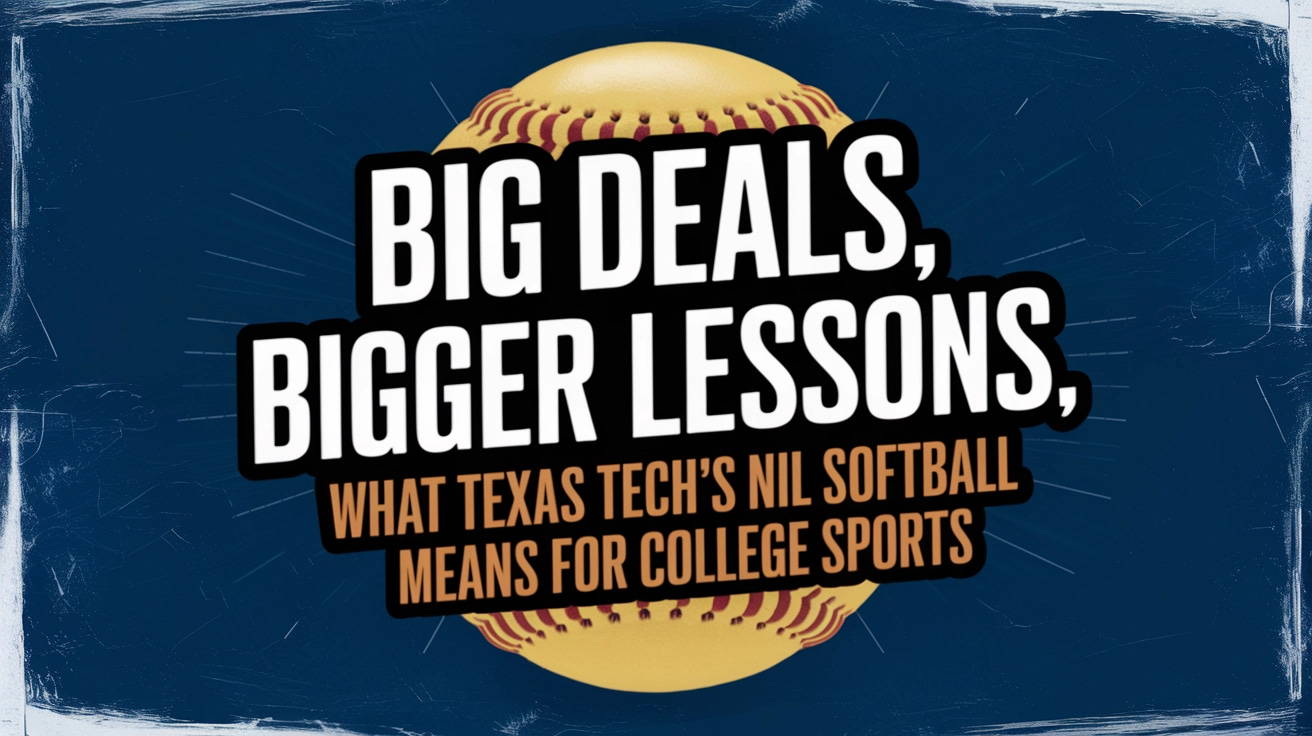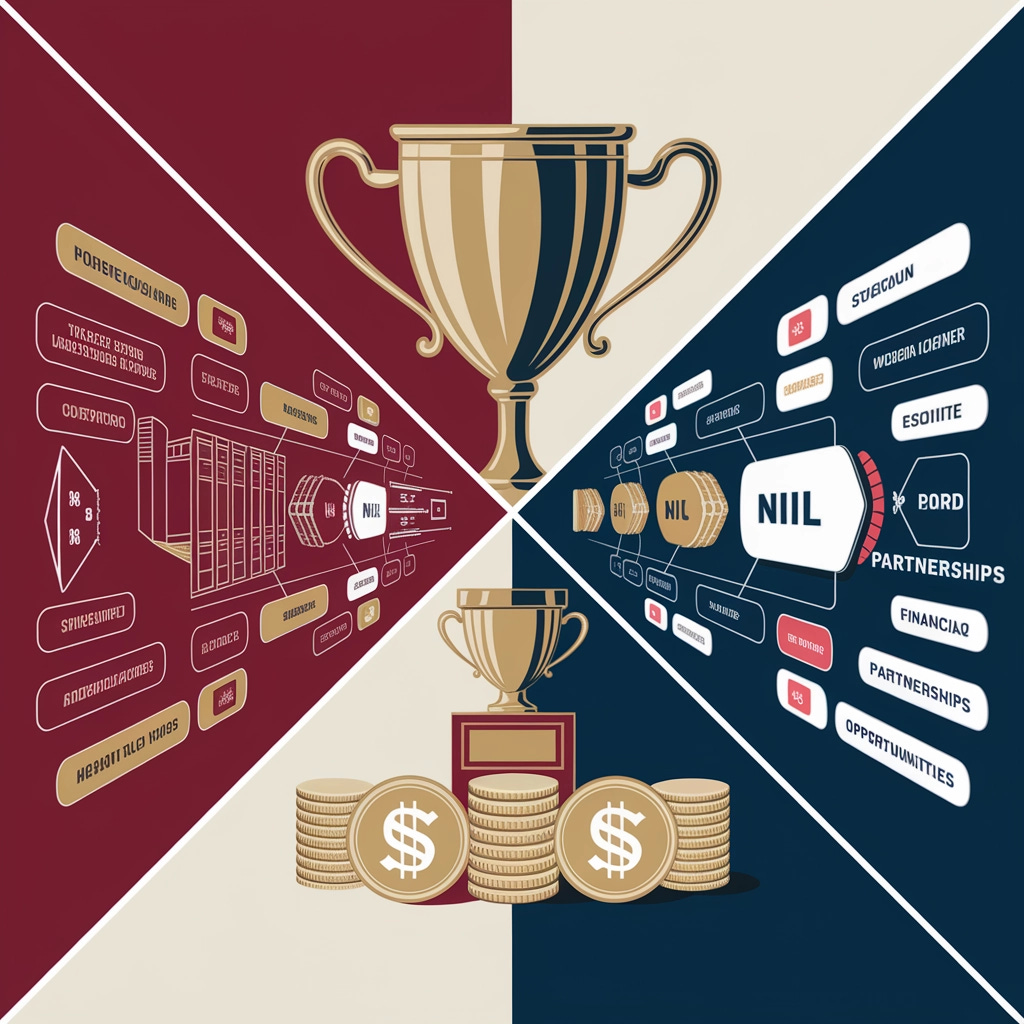Big Deals, Bigger Lessons: What Texas Tech's $1M NIL Softball Star Means for College Sports
When NiJaree Canady inked her historic $1 million NIL deal with Texas Tech, she didn't just secure her financial future – she fundamentally changed the landscape of college athletics. The record-breaking agreement sent shockwaves through the sports world and placed women's college softball squarely in the national spotlight. As we unpack this monumental deal, it's clear that Canady's contract represents far more than just a paycheck; it's a paradigm shift that signals where college sports are headed in 2025 and beyond.
Breaking Barriers: A Historic Milestone for Women's Athletics
Let's start with the jaw-dropping headline: $1 million for a college softball player. Not basketball. Not football. Softball.
For context, just three years ago, the idea of a seven-figure NIL deal for any female college athlete seemed like fantasy. Today, Canady's agreement with Texas Tech stands as the largest NIL deal ever awarded to a college softball player, dramatically resetting expectations across women's collegiate sports.
"This isn't just about one athlete getting paid," notes sports economist Dr. Melissa Thompson. "It's about recalibrating the perceived value of women's sports in the collegiate ecosystem."
Canady's deal validates what many have long argued – that women's sports have been systematically undervalued despite their growing popularity and commercial potential. With viewership for the Women's College World Series consistently climbing year-over-year, this deal reflects market reality rather than charity.
The Transfer That Shocked Stanford: How NIL Is Reshaping Recruitment
Perhaps even more surprising than the dollar amount was Canady's decision to leave Stanford – a perennial softball powerhouse – for Texas Tech, a program that had never won a conference title. This transfer underscores how NIL is fundamentally altering the traditional power dynamics in college sports.
Stanford's academic prestige and championship pedigree have historically been enough to attract and retain top talent. But in today's NIL-driven landscape, athletes like Canady are weighing new factors in their decision-making:
Financial opportunity
Marketing potential
Regional fan engagement
NIL collective support
Commercial partnerships
"When a player of Canady's caliber chooses Texas Tech over Stanford, we're witnessing a seismic shift in recruitment dynamics," explains Mark Rodriguez, recruitment analyst. "Suddenly, programs without traditional blue-blood status can compete for elite talent if they build robust NIL infrastructures."
For athletes, coaches, and athletic directors alike, this transfer represents a case study in how NIL is flattening the competitive landscape in unexpected ways.
The Power Players: NIL Collectives Take Center Stage
The Matador Club, Texas Tech's NIL collective, deserves substantial credit for orchestrating Canady's historic deal. Their ability to coordinate sponsors, donors, and university stakeholders demonstrates the increasingly sophisticated approach to NIL management.
"NIL collectives have evolved from loosely organized booster groups into professional sports management operations," observes Taylor Williams, NIL strategy consultant. "The most successful collectives are those that can create comprehensive packages combining immediate compensation with long-term brand development."
The Matador Club didn't just write a check – they created a strategic platform including:
Branded merchandise and apparel lines
Local business partnerships
Community engagement opportunities
Media training and exposure
Post-collegiate career development
This comprehensive approach mirrors what we at Gameplan NIL emphasize to athletes and athletic departments: successful NIL management requires strategic thinking beyond immediate compensation. Athletes need education on financial literacy, brand building, and long-term planning to truly maximize these opportunities.
Performance Meets Pressure: Delivering Under the Spotlight
With great compensation comes great expectations. Canady's exceptional performance – a 26-5 record with an NCAA-leading 0.81 ERA – demonstrates her ability to thrive under unprecedented scrutiny.
"When you're making history with your contract, every pitch is analyzed through that lens," notes former softball All-American Jessica Martinez. "Canady isn't just playing for wins and losses; she's playing to validate an entire business model."
The psychological component of performing under such conditions cannot be overlooked. Athletes with major NIL deals face unique pressures:
Heightened media attention
Increased fan expectations
Jealousy from peers
Questions about "deserving" compensation
Balancing commercial obligations with athletic performance
Successfully navigating these pressures requires mental fortitude and professional guidance. As NIL deals grow larger, the psychological support systems for athletes must evolve accordingly.
Broader Implications: What This Means for College Sports
Canady's deal represents more than just one athlete's good fortune – it signals fundamental shifts across collegiate athletics:
1. Women's Sports Entering a New Valuation Era
For decades, women's college sports have been treated as cost centers rather than revenue generators. Canady's deal challenges this assumption and forces athletic departments to reconsider how they value, fund, and market women's programs.
"We're seeing women's sports generate significant viewership, engagement, and now NIL activity," says media analyst Sarah Johnson. "Smart athletic departments are realizing there's untapped revenue potential in properly promoting women's athletics."
2. Non-Revenue Sports Finding NIL Footing
While football and basketball have dominated NIL headlines, Canady proves that athletes in "Olympic" sports can secure transformative deals with the right combination of performance, personality, and platform.
"Athletes in non-revenue sports often have compelling stories and dedicated fan bases," explains social media strategist Marcus Chen. "With the right strategy, they can leverage niche audiences that traditional marketing might overlook."
3. Geographic Redistribution of Talent
Traditional power centers in college sports have been concentrated in certain conferences and regions. NIL is beginning to redistribute talent based on new incentive structures.
"We're seeing athletes make decisions based on where they can maximize their NIL potential," notes recruitment expert Julia Fernandez. "Sometimes that means choosing a school where they can be the star rather than just another talented player at a traditional powerhouse."
4. Legal and Regulatory Evolution
Canady's deal comes amid ongoing uncertainty about the legal framework governing NIL. Recent court rulings and pending legislation suggest we're moving toward direct pay-for-play models beyond the current NIL framework.
"Deals of this magnitude blur the lines between NIL and employment," explains sports attorney Michael Thompson. "They're increasing pressure on legislators and the NCAA to establish clearer guidelines around athlete compensation."
Building on the Momentum: What Athletes Can Learn
For college athletes watching Canady's success from afar, several key lessons emerge:
Personal Brand Development Matters
Canady isn't just an exceptional pitcher; she's developed a compelling personal narrative that resonates with fans and sponsors alike. Athletes looking to maximize their NIL potential need to invest time in authentic brand building.
Financial Literacy Is Essential
A million-dollar deal requires sophisticated financial management. Understanding taxation, investment strategies, and long-term planning becomes crucial when handling significant compensation.
Think Beyond College
The most forward-thinking athletes are using NIL opportunities to build platforms that will continue generating value long after their collegiate careers end. This might include developing media skills, business relationships, or entrepreneurial ventures.
Seek Professional Guidance
Navigating complex NIL opportunities requires specialized knowledge. Athletes benefit from working with experienced advisors who understand both the opportunities and pitfalls in this evolving landscape.
The Future of NIL: Where Do We Go From Here?
As landmark deals like Canady's become more common, we can expect several developments in the NIL ecosystem:
Increased Specialization: NIL management will become more sophisticated, with specialized services for different sports, regions, and athlete profiles.
Earlier Engagement: High school athletes will receive more NIL education and preparation before reaching college.
Institutional Integration: Universities will develop more comprehensive in-house NIL support programs rather than outsourcing entirely to collectives.
Data-Driven Valuation: More sophisticated metrics will emerge to help determine fair market value for athletes across different sports.
Regulatory Clarity: Federal legislation or NCAA policy changes will eventually provide clearer frameworks for NIL activities.
Conclusion: A Watershed Moment Worth Celebrating
NiJaree Canady's historic deal represents a watershed moment in college sports – particularly for women athletes who have long been undervalued despite their contributions. As college athletics continues its rapid evolution, deals like this establish new benchmarks for what's possible.
For athletic departments, athletes, and NIL professionals, this moment demands thoughtful adaptation rather than resistance. The programs that thrive will be those that embrace these changes while helping athletes navigate them responsibly.
At Gameplan NIL, we've observed that the most successful athletes approach NIL opportunities with a strategic mindset focused on long-term value creation rather than short-term gains. As Canady demonstrates, when exceptional talent meets exceptional opportunity, the results can be truly game-changing.
For college sports, Canady's million-dollar deal isn't just big news – it's a glimpse into the future. And that future looks increasingly promising for athletes who previously stood in the shadows of revenue-generating sports. The playing field is leveling, and we're just beginning to understand what that means for college athletics as we know it.










